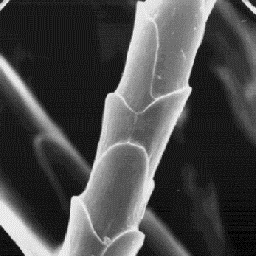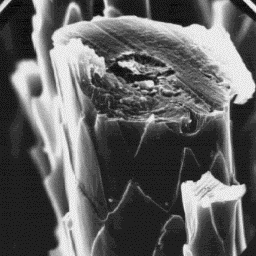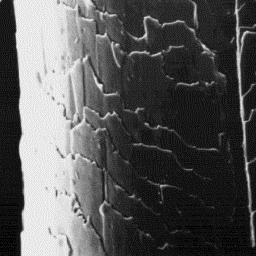 Putorius putorius
Putorius putorius
-----------------
English: European polecat
German: Iltis
French: Putois
Spanish: Turon
Distribution areas
------------------
The European polecat lives in the
temperate zones of Europe and Asia. Three
other species of polecat are known. The
European polecat is now bred on fur farms.
Description of the fur
---------------------- A group of the fine hairs,
The skins are from 35 to 50 cm long. The 1000x
coat is fine with a clearly distinguishable
undercoat layer which is light-yellowish in colour. The guard hairs are
straight and dark-brown or black in colour. On the throat and above the eyes,
the skin has yellow-white (male) or white (female) spots.
|
|
 Putorius putorius
Putorius putorius
-----------------
English: European polecat
German: Iltis
French: Putois
Spanish: Turon
Structure of the hair
---------------------
The microscopic skin surface is furrowed
and the hair follicles are narrow with
straight edges. The average follicle
contains a cluster of 4 to 8 hairs.
The fine fur fibres are circular in
cross-section. Their diameter is in the The cuticular structure
range of 10 to 18 µm. The cuticular scales of the fine fibres, 2000x
are cornet-like at the bottom of the shaft,
and petal-like along the rest of the shaft's length. The scale surface is
finely grooved and the scale margins are straight. These fine fibres are
non-medullated.
|
|
 Putorius putorius
Putorius putorius
-----------------
English: European polecat
German: Iltis
French: Putois
Spanish: Turon
The intermediate fibres have a circular,
and in the upper part of the shaft
ellipsoidal cross-sectional outline with a
diameter in the range of 30 to 60 µm. The
cuticular scales are either comb-like or
wavelike in shape, with a grooved scale
surface and straight margins. The medulla
is narrow, unbroken and central
symmetrical-shaped in cross-section. The Transverse section
overall medullar structure belongs to the of an intermediate fibre, 1000x
uniserial ladder type with either a
foam-like or amorphous infilling material.
The guard hair fibres are circular or ellipsoidal in cross-sectional
outline with a diameter of between 70 and 130 µm. The cuticular scales are
usually crenated tile-like with a smooth surface and rippled scale margins.
The medullar column is wide, unbroken and central symmetrical shaped. The
medullar structure belongs to the lattice type with a perforated sheet-like
infilling substance.
|
|
 Putorius putorius
Putorius putorius
-----------------
English: European polecat
German: Iltis
French: Putois
Spanish: Turon
The cuticular structure
of a guard hair, 2000x
|
|
 Putorius putorius
Putorius putorius
-----------------
English: European polecat
German: Iltis
French: Putois
Spanish: Turon
Longitudinal section
of a guard hair, 600x
Numerical code for European polecat skin structure
--------------------------------------------------
Surface of the skin: 3-4-3
Fine fur fibres: 1-11.5-2-1-4-0-0-0-0-10.18-5.15
Intermediate fibres: 2.1-6.7-2-1-3-1-1-1-5.8-30.61-10.26
Guard hairs: 2.1-4-1-2-2-1-1-8-2-70.131-20.45
|




